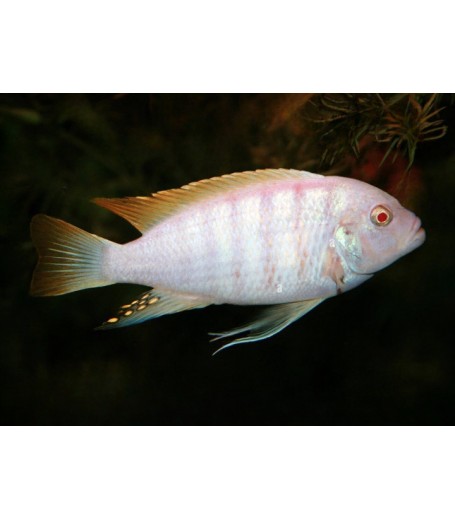ALBINO RED TOP ZEBRA
- RM0.00
Profile: Zebra Mbuna, Zebra Cichlid, Cobalt Blue Cichlid, Zebra Malawi Cichlid, Nyasa Blue Cichlid
Pseudotropheus / Metriaclima zebra Synonyms: Tilapia zebra
Physical description: The Zebra Cichlid has a "typical" mbuna shape. The coloring depends on the geographical population and mood of the fish. The most common color variety has a pale blue body with seven to eight, dark blue or black, vertical bands. All flanks are pale blue. Another variety or "mood coloration" is simply pale blue in color. Albino and white variations are very common, as is a "Red" or "Tangerine" form, and several blotched "OB" varieties.
Size/Length: Males to 6" (15 cm), females to 5" (13 cm)
Similar species: Eduard's Mbuna ( P. socolofi), Golden Tropheus ( P. tropheus), and other Pseudotropheus species.
Habitat: Eastern Africa; rocky shores of Lake Malawi
S: bottom, middle
Aquarium: 36" (91 cm) or 35 gallons (132 L) is sufficient only for specimen measuring up to 3.5" (9 cm). This territorial fish requires a minimum tank size of 48" (122 cm) or 55 gallons (209 L) as an adult. Arrange the tank as one would for other Lake Malawi Mbunas.
Water chemistry: pH 7.2-9.0 (8.1), 12-25 dH (16), 72-82°F (22-28°C)
Social behavior: The Zebra Mbuna is an aggressive fish towards similar and dissimilar species. Tensions between fish are reduced when the Zebra Mbuna is kept in a large tank will many hiding places, and combined with different-looking species and morphs. Keep one male with several females. Females have a tendency to school. Males establish large territories which are defended with strength.
Suggested companions: Small Haplochromines, mbunas, Synodontis, Aulonocara
FOOD: Algae; flake; live; snails, bloodworms, mosquito larvae, microorganisms, crustaceans, snails, Tubifex ; pellets; tablets; plant matter; vegetables; peas, lettuce, spinach; fruit.
Sexual differences: Males have stronger and more obvious egg-spots, and will develop a hump on the forehead with age.
Breeding techniques: Use water with a temperature from 77-82°F (25-28°C), a pH from 8.0-8.8, and a hardness from 10-16 dH. The male is polygamous, so use several females. As many as 60 eggs are laid and fertilized via the dummy-egg method. The female mouth broods the eggs for 20-25 days. The female continues her cave for 8-10 days after the fry are free-swimming. The young can be fed Artemia, Cyclops, Daphnia and dry foods.
Breeding potential: 6. Breeding is fairly easy.
Reviews
There are no reviews for this product.



